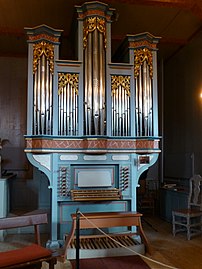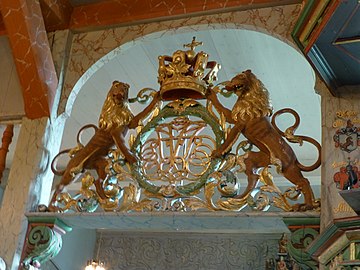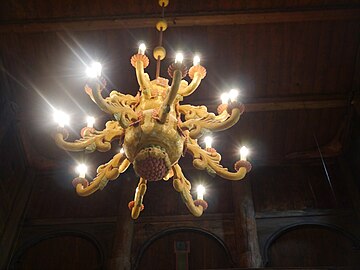Ringebu Stave Church
| Ringebu Stave Church | |
|---|---|
| Ringebu stavkyrkje | |
 View of the church | |
 | |
| 61°30′34″N10°10′23″E/ 61.50933902227°N 10.1729978621°E | |
| Location | Ringebu Municipality, Innlandet |
| Country | Norway |
| Denomination | Church of Norway |
| Previous denomination | Catholic Church |
| Churchmanship | Evangelical Lutheran |
| History | |
| Status | Parish church |
| Founded | c. 1220 |
| Consecrated | c. 1220 |
| Architecture | |
| Functional status | Active |
| Architectural type | Stave church |
| Style | Romanesque |
| Completed | c. 1220 |
| Specifications | |
| Materials | Wood |
| Administration | |
| Diocese | Hamar bispedømme |
| Deanery | Sør-Gudbrandsdal prosti |
| Parish | Ringebu |
| Type | Church |
| Status | Automatically protected |
| ID | 85295 |
Ringebu Stave Church(Norwegian:Ringebu stavkyrkje) is aparish churchof theChurch of NorwayinRingebu MunicipalityinInnlandetcounty,Norway.It is located in the village ofRingebuin theGudbrandsdalenvalley. It is the church for the Ringebuparishwhich is part of theSør-Gudbrandsdal prosti(deanery) in theDiocese of Hamar.The brown, wooden church was built in astave churchdesign around the year 1220 using plans drawn up by an unknownarchitect.The church seats about 300 people.[1][2][3][4][5]
History
[edit]The earliest existing historical records of the church date back to the year 1270, but the church was not new that year. The first church in Ringebu was a woodenpost churchthat was built in the 11th century. This church was in use for about 200 years before it was torn down in the early 13th century. A new woodenstave churchwas then built on the same site.Dendrochronologicaldating of the logs used to build this church show that the logs were cut in the 1190s, so the church must have been constructed in the early 1200s. This church had along churchdesign.[6][7]
Around the year 1630, the master-builderWerner Olsen(ca. 1600–1682) began a large expansion and renovation project on the church.[8]Thenavewas enlarged by adding atranseptwing to the north and south, creating acruciformfloor plan. A new central tower was constructed on the roof over the central part of the nave. This significant renovation changed the character of the church and it left several free standing posts in the interior of the nave that remained from the original stave church, but most of the rest of the building looked quite new at the time. The church was painted in 1717, but only the lower half of the walls were done, since the ceiling at that time was lower.[6][7]
In 1814, this church served as anelection church(Norwegian:valgkirke).[9][10]Together with more than 300 other parish churches across Norway, it was a polling station for elections to the 1814Norwegian Constituent Assemblywhich wrote theConstitution of Norway.This was Norway's first national elections. Eachchurch parishwas a constituency that elected people called "electors" who later met together in each county to elect the representatives for the assembly that was to meet inEidsvolllater that year.[9][11]
Later restoration in 1921 brought it back a bit closer to its original shape. At one point the church was painted white within, but during the restoration work byRagnvald Einbuin 1921 the church interior was restored to its original colouring.[12][6]
There have been some archaeological surveys of the ground under the church. The last one took place in 1980–1981. These surveys resulted in the finding of about 900 old coins, mostly frommedieval times,especially from the period 1217–1263. Post holes from an older church were also found, supporting the tradition that a church had stood on the site before the present building. Thepost churchis assumed to be a forerunner of the stave church. The earth-bound posts of these churches were planted directly into the ground, and therefore they were exposed to humidity which caused them to rot over the years.[13][14][6][7]
Media gallery
[edit]-
Ringebu Stave Church spire
-
Altar
-
Organ
-
Coat-of–Arms
-
Chandelier
See also
[edit]References
[edit]- ^"Ringebu stavkyrkje".Kirkesøk: Kirkebyggdatabasen.Retrieved19 December2021.
- ^"Oversikt over Nåværende Kirker"(in Norwegian). KirkeKonsulenten.no.Retrieved19 December2021.
- ^"Ringebu stavkirke".Riksantikvaren. 18 July 2016.Retrieved1 October2017.
- ^"Ringebu stavkirke".stavkirke.no.Retrieved1 October2017.
- ^"Ringebu stavkirke".Sons of Norway.Retrieved1 October2017.
- ^abcd"Ringebu stavkirke".Norges-Kirker.no(in Norwegian).Retrieved19 December2021.
- ^abc"Ringebu stavkirke"(in Norwegian).Norwegian Directorate for Cultural Heritage.Retrieved19 December2021.
- ^Kåre Hosar."Werner Olsen".Norsk kunstnerleksikon.Retrieved1 October2017.
- ^ab"Valgkirkene".LokalHistorieWiki.no(in Norwegian).Retrieved19 December2021.
- ^"Valgkartet".Valgene i 1814(in Norwegian). Arkivverket. Archived fromthe originalon 24 June 2021.Retrieved19 December2021.
- ^"Om valgene".Valgene i 1814(in Norwegian). Arkivverket.Retrieved19 December2021.
- ^"Ringebu stavkirke".Den norske kirke.Retrieved1 October2017.
- ^"Ringebu Stave Church".pilegrimsleden.no.Retrieved1 October2017.
- ^Jørgen H. Jensenius."Ringebu stavkyrkje".Stavkirke.info.Retrieved1 October2017.
Further reading
[edit]- Anker, Leif (2005).The Norwegian Stave Churches.Oslo: Arfo Forlag.ISBN9788291399294.
External links
[edit]









